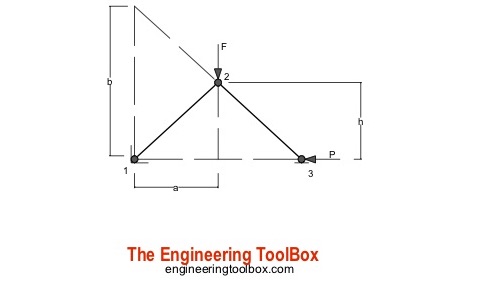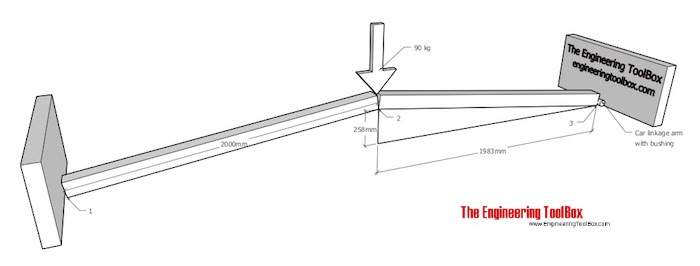Toggle Joint (original) (raw)

The toggle mechanism is made of two arms linked together. Point 1 is fixed, point 3 can move horizontally (as indicated in this principal drawing). The effort force acts vertically in point 2.
The horizontal force acting in point 3 can be calculated for arms with equal or unequal lengths.
Arms with equal lengths
P = F a / 2 h (1)
where
P = horizontal force in point 3 (N, lb)
F = effort force (N, lb)
a = length (m, ft)
h = height (m, ft)
Arms with unequal lengths
P = F a / b (2)
where
b = length (m, ft)
Example - An Improvised Press for Replacing Car Bushings
A press to remove/refit bushings in car linkage arms can be improvised with two pieces of lumber:

The effort force acting on the toggle joint (in point 2) with a person with weight 90 kg can be calculated as
F = (90 kg) (9.81 m/s2)
= 883 N
The force acting on the bush (in point 3) can be calculated as
P = F a / 2 h
= (883 N) (1983 mm) / (2 (258 mm))
= 3393 N
The force ratio is
Fr = (3393 N) / (883 N)
= 3.8
- the initial effort force is amplified near four times
Toggle Joint Calculator
This calculator can be used to calculate the resulting force in a toggle joint with arms with equal lengths. The calculator can be used for imperial and metric units as long as the use of units are consistent.
F - force (N, kg, lb)
a - length (m, mm, in, ft)
h - height (m, mm, in, ft)
Note that kg is the SI unit of mass - check the difference between mass and weight (force).